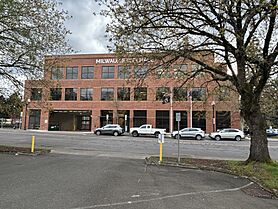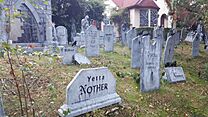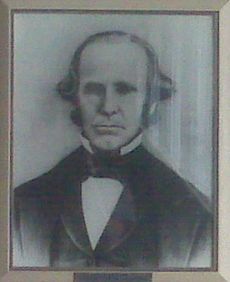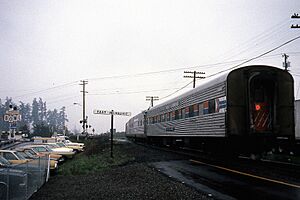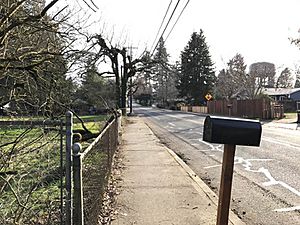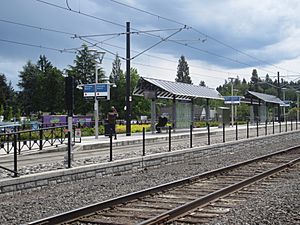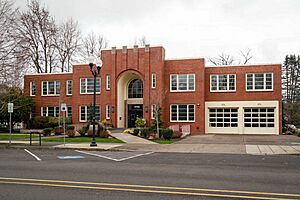Milwaukie, Oregon facts for kids
Quick facts for kids
Milwaukie
|
|
|---|---|
| City of Milwaukie, Oregon | |
|
Milwaukie City Hall
The headquarters of Dark Horse Comics
The original Pietro's Pizza location
The Milwaukie Masonic Lodge
Christ the King Catholic Church
The Vietnam War Memorial
The Davis Graveyard annual Halloween display
|
|
| Nickname(s):
The Dogwood City of the West, Home of the Bing Cherry
|
|
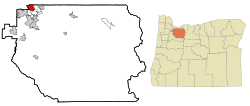
Location within Clackamas County and the State of Oregon
|
|
| Country | United States |
| State | Oregon |
| County | Clackamas |
| Founded | 1847 |
| Platted | 1849 |
| Named for | Milwaukee, Wisconsin |
| Government | |
| • Type | Mayor–council |
| • Body | Milwaukie City Council |
| Area | |
| • Total | 5.14 sq mi (13.32 km2) |
| • Land | 4.98 sq mi (12.91 km2) |
| • Water | 0.16 sq mi (0.41 km2) |
| Elevation | 154 ft (47 m) |
| Population
(2020)
|
|
| • Total | 21,119 |
| • Density | 4,237.36/sq mi (1,636.14/km2) |
| Time zone | UTC−8 (Pacific (PST)) |
| • Summer (DST) | UTC−7 (PDT) |
| ZIP Code |
97222, 97267, 97269
|
| Area code | 503 and 971 |
| FIPS code | 41-48650 |
| GNIS feature ID | 2411116 |
Milwaukie /mɪlˈwɔːki/ is a city in Oregon, United States. Most of it is in Clackamas County. A small part is in Multnomah County. In 2020, about 21,119 people lived there.
The city was started in 1847 along the Willamette River. It is known as the "Dogwood City of the West." It is also famous as the place where the Bing cherry was first grown. Milwaukie became an official city in 1903. Today, it is a suburb of Portland.
Contents
History of Milwaukie
The Clackamas people lived on this land first. Milwaukie was settled in 1847 by Lot Whitcomb. He officially planned the town in 1849. Whitcomb named it after Milwaukee, Wisconsin. At that time, both cities often spelled their names "Milwaukie." The Oregon city kept this spelling to avoid confusion at the post office.
Lot Whitcomb came to Oregon in 1848. He built a sawmill and a gristmill here. For a while, Milwaukie was a strong competitor to Portland and Oregon City. But Portland grew larger because its port was deeper. The first post office in Milwaukie opened in 1850. Lot Whitcomb was the first postmaster. The town officially became the "Town of Milwaukie" on February 4, 1903.
The Oregon and California Railroad built a station here in 1870. They first called it Milwaukee, but changed it to Milwaukie in 1892. Later, this station was replaced and renamed Lambert. This new name honored Joseph H. Lambert, who grew fruit and developed the Lambert cherry. The station's name changed again to East Milwaukee in 1913, then to East Milwaukie in 1916.
The famous Bing cherry was created in Milwaukie. It was developed by Ah Bing, who worked for Seth Lewelling. A large painting in the city celebrates Ah Bing's important work.
Geography and Parks
Milwaukie covers about 4.85 square miles (12.56 square kilometers). Most of this is land, with a small amount of water.
The city has several nice parks for everyone to enjoy:
- Dogwood Park
- Elk Rock Island
- Kronberg Park
- Milwaukie Riverfront Park
- Spring Park
Milwaukie's Population
How Many People Live Here?
| Historical population | |||
|---|---|---|---|
| Census | Pop. | %± | |
| 1880 | 125 | — | |
| 1890 | 489 | 291.2% | |
| 1910 | 860 | — | |
| 1920 | 1,172 | 36.3% | |
| 1930 | 1,767 | 50.8% | |
| 1940 | 1,871 | 5.9% | |
| 1950 | 5,253 | 180.8% | |
| 1960 | 9,099 | 73.2% | |
| 1970 | 16,444 | 80.7% | |
| 1980 | 17,931 | 9.0% | |
| 1990 | 18,692 | 4.2% | |
| 2000 | 20,490 | 9.6% | |
| 2010 | 20,291 | −1.0% | |
| 2020 | 21,119 | 4.1% | |
| Sources: | |||
In 2020, Milwaukie had 21,119 people living there. There were 9,286 households. A household is a group of people living in one home. The city had about 4,382 people per square mile.
Most residents (83.1%) were White. About 10.1% of the population was Hispanic or Latino.
The average age in Milwaukie was 40.2 years old. About 18.1% of residents were under 18. Many people (32.7%) were between 25 and 44 years old.
Economy and Jobs
Milwaukie's downtown area has been growing. New apartments and shops have been built. A new riverfront park was also created.
Milwaukie is home to Dark Horse Comics. This company publishes popular comics like Sin City and 300. They also created characters like Hellboy. Dark Horse Comics has made many movies and TV shows, including The Mask. Their offices take up three city blocks in downtown Milwaukie.
Bob's Red Mill is another big company in Milwaukie. It makes natural and organic foods. Many people work there.
Top Employers in Milwaukie
Here are some of the biggest employers in Milwaukie:
| # | Employer | # of Employees |
|---|---|---|
| 1 | Oregon Tool | 810 |
| 2 | Providence Milwaukie Hospital | 642 |
| 3 | North Clackamas School District | 486 |
| 4 | PCC Structurals Inc. | 431 |
| 5 | Oeco LLC | 227 |
| 6 | ODS Plaza | 200 |
| 7 | Consonus Pharmacy Services | 176 |
| 8 | Wendell & Wild | 164 |
| 9 | Dave's Killer Bread | 163 |
| 10 | Alpine Food Distributing | 156 |
Housing in Milwaukie
Milwaukie's housing market grew a lot in 2015–2016. It was even called one of the "hottest" real estate markets. This growth happened after the MAX Orange Line opened in 2015. This new light rail line connects Milwaukie directly to downtown Portland.
After the Orange Line opened, housing prices went up by 12.2%. City officials also noted that there were no empty storefronts downtown. The city also finished a $2.2 million project to improve its waterfront park. The park had a grand opening in May 2015.
Education in Milwaukie
Milwaukie is part of the North Clackamas School District. Most students go to one of nine elementary schools. They then attend Alder Creek Middle School or Wilbur Rowe Middle School. For high school, students go to Rex Putnam High School or Milwaukie High School. There are also alternative schools like New Urban High School.
Since 1996, Milwaukie High School has hosted "Living History Day." On this day, many veterans visit the school. They share their experiences to help students learn about the past.
There is also a private Catholic high school, La Salle High School. Another private school is the Portland Waldorf School, which teaches students from kindergarten to 12th grade.
The city has its own public library, the Ledding Library. It is part of the Library Information Network of Clackamas County. Milwaukie also has a college campus, Clackamas Community College Harmony.
Transportation in Milwaukie
Public Transit Today
Milwaukie is served by TriMet, the local public transit system. Many TriMet bus lines run through the city. In 1981, TriMet created a transit center in downtown Milwaukie. This was a main spot for bus transfers.
On September 12, 2015, MAX Light Rail service came to Milwaukie. The MAX Orange Line connects Portland and Milwaukie. This project started in 2011. The 7.3-mile (11.7 km) line was completed in May 2015. Regular passenger service began four months later.
Past Transportation Methods
Streetcars started serving Milwaukie in 1892. The East Side Railway extended its service here. They built a workshop in downtown Milwaukie. The next year, the line went to Oregon City. This allowed interurban service (like a long-distance streetcar) between Portland and Oregon City, through Milwaukie.
Different companies ran the streetcar and interurban service over the years. All interurban service stopped in January 1958. It wasn't until 1986 that interurban service returned with MAX light rail. Bus service was also provided by companies like Intercity Buses, Inc. In 1970, TriMet took over these bus companies. TriMet has been the main transit provider in Milwaukie ever since.
Former Train Service
Amtrak passenger trains pass through Milwaukie but do not stop. However, in the early 1980s, an experimental Amtrak train called the Willamette Valley Express did stop in Milwaukie. This service ran twice a day between Portland and Eugene. It started in August 1980 but ended in late 1981.
Notable People from Milwaukie
Many interesting people have connections to Milwaukie:
- Bella Bixby – a soccer goalkeeper for Portland Thorns FC.
- Mike Bliss – a NASCAR driver.
- Scott Brosius – a Major League Baseball player for the Oakland Athletics and New York Yankees.
- Dave Husted – a professional bowler who won the PBA U.S. Open three times.
- Keynan Middleton – a Major League pitcher for the Seattle Mariners.
- Mike Richardson – the founder of Dark Horse Comics.
- Chael Sonnen – a mixed martial arts (MMA) fighter.
- Dorothy Hester Stenzel – an aviator and stunt pilot.
- Monroe Sweetland – a politician.
See also
 In Spanish: Milwaukie para niños
In Spanish: Milwaukie para niños


